The Relationship Between Staff Turnover and Leadership: Boots Plc
VerifiedAdded on 2020/11/23
|32
|8111
|476
Report
AI Summary
This report examines the correlation between staff turnover and leadership, focusing on Boots as a case study. It begins with an introduction to corporate strategy and governance, highlighting the significance of employee turnover and its impact on organizational performance. The report outlines the background of the issue, emphasizing the financial and operational consequences of high staff turnover, including direct and indirect costs, and its effects on productivity, service quality, and brand reputation. The aim of the study is to investigate the relationship between staff turnover and leadership, addressing research objectives that include determining the indicators of staff turnover, identifying the main indicators of good leadership, and analyzing their relationship. The literature review covers determinants of staff turnover such as low compensation and lack of enforcement of labor rules, and the impact of turnover on cost implications, business performance, and control. The report also explores Porter's Generic strategies and Maslow's motivational theory, providing a comprehensive analysis of the factors influencing staff turnover and the role of leadership in mitigating this issue. The report also includes research questions, the rationale of the study, and a detailed literature review, offering insights into the determinants of staff turnover, indicators of good leadership, and the relationship between the two. The study aims to provide recommendations for Boots to achieve staff retention.
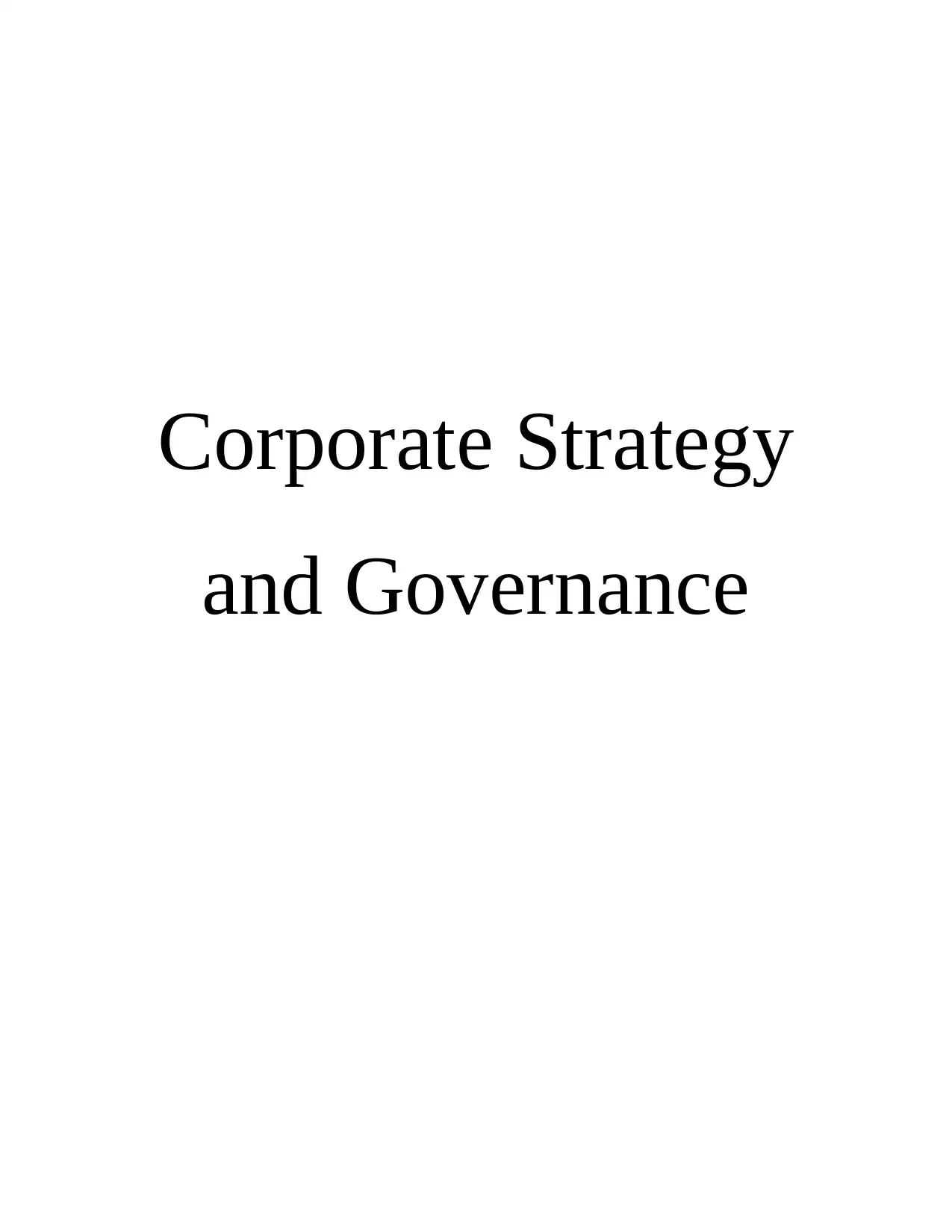
Corporate Strategy
and Governance
and Governance
Paraphrase This Document
Need a fresh take? Get an instant paraphrase of this document with our AI Paraphraser
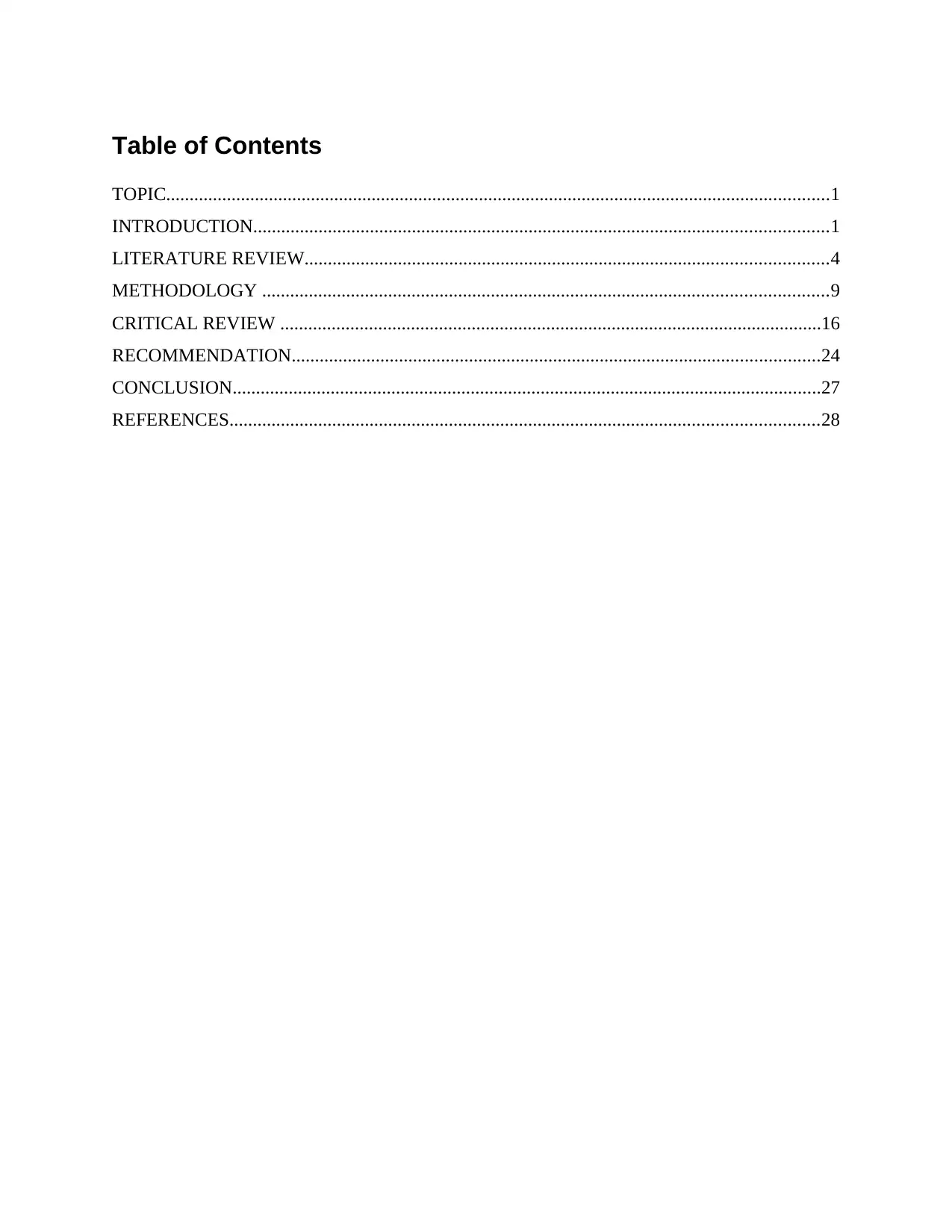
Table of Contents
TOPIC..............................................................................................................................................1
INTRODUCTION...........................................................................................................................1
LITERATURE REVIEW................................................................................................................4
METHODOLOGY .........................................................................................................................9
CRITICAL REVIEW ....................................................................................................................16
RECOMMENDATION.................................................................................................................24
CONCLUSION..............................................................................................................................27
REFERENCES..............................................................................................................................28
TOPIC..............................................................................................................................................1
INTRODUCTION...........................................................................................................................1
LITERATURE REVIEW................................................................................................................4
METHODOLOGY .........................................................................................................................9
CRITICAL REVIEW ....................................................................................................................16
RECOMMENDATION.................................................................................................................24
CONCLUSION..............................................................................................................................27
REFERENCES..............................................................................................................................28
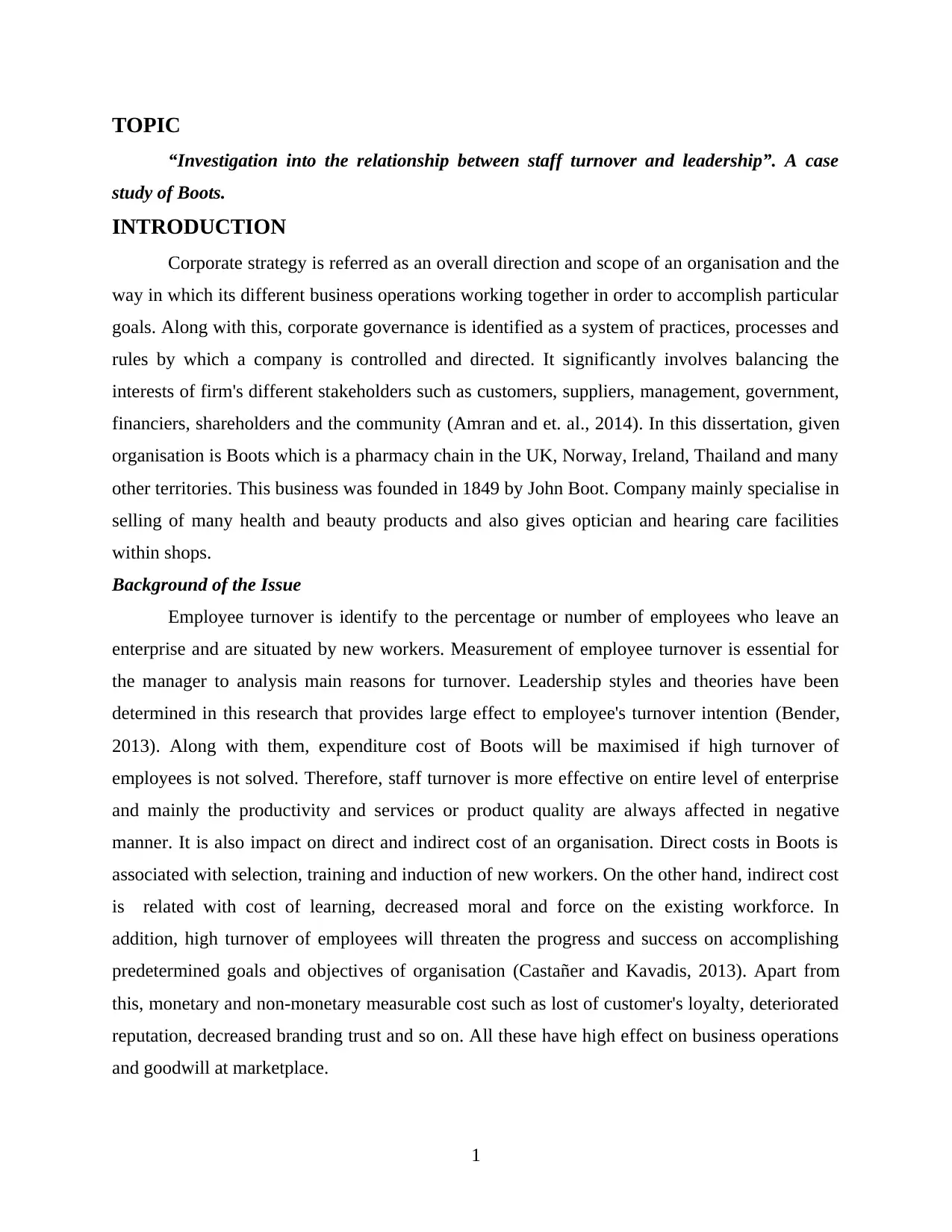
TOPIC
“Investigation into the relationship between staff turnover and leadership”. A case
study of Boots.
INTRODUCTION
Corporate strategy is referred as an overall direction and scope of an organisation and the
way in which its different business operations working together in order to accomplish particular
goals. Along with this, corporate governance is identified as a system of practices, processes and
rules by which a company is controlled and directed. It significantly involves balancing the
interests of firm's different stakeholders such as customers, suppliers, management, government,
financiers, shareholders and the community (Amran and et. al., 2014). In this dissertation, given
organisation is Boots which is a pharmacy chain in the UK, Norway, Ireland, Thailand and many
other territories. This business was founded in 1849 by John Boot. Company mainly specialise in
selling of many health and beauty products and also gives optician and hearing care facilities
within shops.
Background of the Issue
Employee turnover is identify to the percentage or number of employees who leave an
enterprise and are situated by new workers. Measurement of employee turnover is essential for
the manager to analysis main reasons for turnover. Leadership styles and theories have been
determined in this research that provides large effect to employee's turnover intention (Bender,
2013). Along with them, expenditure cost of Boots will be maximised if high turnover of
employees is not solved. Therefore, staff turnover is more effective on entire level of enterprise
and mainly the productivity and services or product quality are always affected in negative
manner. It is also impact on direct and indirect cost of an organisation. Direct costs in Boots is
associated with selection, training and induction of new workers. On the other hand, indirect cost
is related with cost of learning, decreased moral and force on the existing workforce. In
addition, high turnover of employees will threaten the progress and success on accomplishing
predetermined goals and objectives of organisation (Castañer and Kavadis, 2013). Apart from
this, monetary and non-monetary measurable cost such as lost of customer's loyalty, deteriorated
reputation, decreased branding trust and so on. All these have high effect on business operations
and goodwill at marketplace.
1
“Investigation into the relationship between staff turnover and leadership”. A case
study of Boots.
INTRODUCTION
Corporate strategy is referred as an overall direction and scope of an organisation and the
way in which its different business operations working together in order to accomplish particular
goals. Along with this, corporate governance is identified as a system of practices, processes and
rules by which a company is controlled and directed. It significantly involves balancing the
interests of firm's different stakeholders such as customers, suppliers, management, government,
financiers, shareholders and the community (Amran and et. al., 2014). In this dissertation, given
organisation is Boots which is a pharmacy chain in the UK, Norway, Ireland, Thailand and many
other territories. This business was founded in 1849 by John Boot. Company mainly specialise in
selling of many health and beauty products and also gives optician and hearing care facilities
within shops.
Background of the Issue
Employee turnover is identify to the percentage or number of employees who leave an
enterprise and are situated by new workers. Measurement of employee turnover is essential for
the manager to analysis main reasons for turnover. Leadership styles and theories have been
determined in this research that provides large effect to employee's turnover intention (Bender,
2013). Along with them, expenditure cost of Boots will be maximised if high turnover of
employees is not solved. Therefore, staff turnover is more effective on entire level of enterprise
and mainly the productivity and services or product quality are always affected in negative
manner. It is also impact on direct and indirect cost of an organisation. Direct costs in Boots is
associated with selection, training and induction of new workers. On the other hand, indirect cost
is related with cost of learning, decreased moral and force on the existing workforce. In
addition, high turnover of employees will threaten the progress and success on accomplishing
predetermined goals and objectives of organisation (Castañer and Kavadis, 2013). Apart from
this, monetary and non-monetary measurable cost such as lost of customer's loyalty, deteriorated
reputation, decreased branding trust and so on. All these have high effect on business operations
and goodwill at marketplace.
1
⊘ This is a preview!⊘
Do you want full access?
Subscribe today to unlock all pages.

Trusted by 1+ million students worldwide
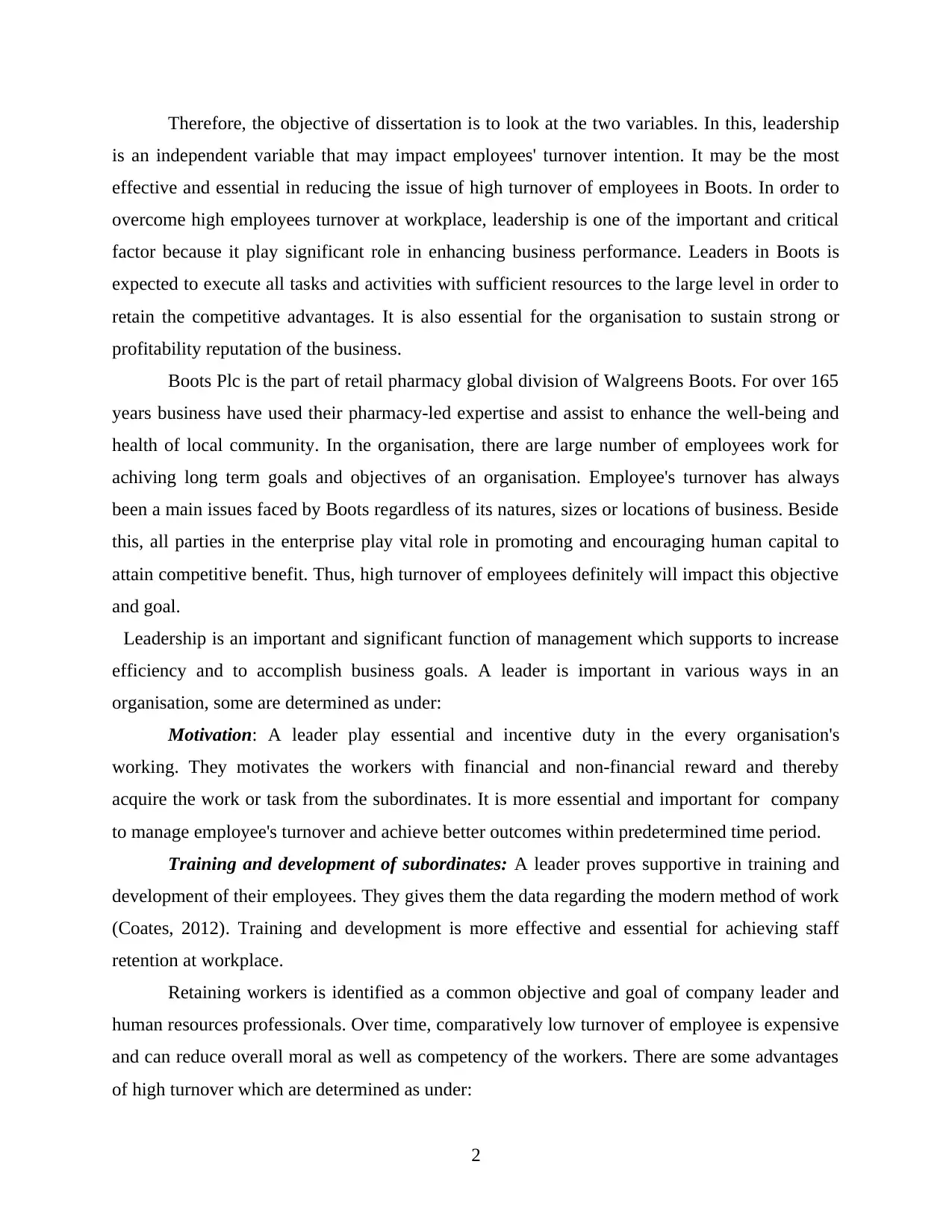
Therefore, the objective of dissertation is to look at the two variables. In this, leadership
is an independent variable that may impact employees' turnover intention. It may be the most
effective and essential in reducing the issue of high turnover of employees in Boots. In order to
overcome high employees turnover at workplace, leadership is one of the important and critical
factor because it play significant role in enhancing business performance. Leaders in Boots is
expected to execute all tasks and activities with sufficient resources to the large level in order to
retain the competitive advantages. It is also essential for the organisation to sustain strong or
profitability reputation of the business.
Boots Plc is the part of retail pharmacy global division of Walgreens Boots. For over 165
years business have used their pharmacy-led expertise and assist to enhance the well-being and
health of local community. In the organisation, there are large number of employees work for
achiving long term goals and objectives of an organisation. Employee's turnover has always
been a main issues faced by Boots regardless of its natures, sizes or locations of business. Beside
this, all parties in the enterprise play vital role in promoting and encouraging human capital to
attain competitive benefit. Thus, high turnover of employees definitely will impact this objective
and goal.
Leadership is an important and significant function of management which supports to increase
efficiency and to accomplish business goals. A leader is important in various ways in an
organisation, some are determined as under:
Motivation: A leader play essential and incentive duty in the every organisation's
working. They motivates the workers with financial and non-financial reward and thereby
acquire the work or task from the subordinates. It is more essential and important for company
to manage employee's turnover and achieve better outcomes within predetermined time period.
Training and development of subordinates: A leader proves supportive in training and
development of their employees. They gives them the data regarding the modern method of work
(Coates, 2012). Training and development is more effective and essential for achieving staff
retention at workplace.
Retaining workers is identified as a common objective and goal of company leader and
human resources professionals. Over time, comparatively low turnover of employee is expensive
and can reduce overall moral as well as competency of the workers. There are some advantages
of high turnover which are determined as under:
2
is an independent variable that may impact employees' turnover intention. It may be the most
effective and essential in reducing the issue of high turnover of employees in Boots. In order to
overcome high employees turnover at workplace, leadership is one of the important and critical
factor because it play significant role in enhancing business performance. Leaders in Boots is
expected to execute all tasks and activities with sufficient resources to the large level in order to
retain the competitive advantages. It is also essential for the organisation to sustain strong or
profitability reputation of the business.
Boots Plc is the part of retail pharmacy global division of Walgreens Boots. For over 165
years business have used their pharmacy-led expertise and assist to enhance the well-being and
health of local community. In the organisation, there are large number of employees work for
achiving long term goals and objectives of an organisation. Employee's turnover has always
been a main issues faced by Boots regardless of its natures, sizes or locations of business. Beside
this, all parties in the enterprise play vital role in promoting and encouraging human capital to
attain competitive benefit. Thus, high turnover of employees definitely will impact this objective
and goal.
Leadership is an important and significant function of management which supports to increase
efficiency and to accomplish business goals. A leader is important in various ways in an
organisation, some are determined as under:
Motivation: A leader play essential and incentive duty in the every organisation's
working. They motivates the workers with financial and non-financial reward and thereby
acquire the work or task from the subordinates. It is more essential and important for company
to manage employee's turnover and achieve better outcomes within predetermined time period.
Training and development of subordinates: A leader proves supportive in training and
development of their employees. They gives them the data regarding the modern method of work
(Coates, 2012). Training and development is more effective and essential for achieving staff
retention at workplace.
Retaining workers is identified as a common objective and goal of company leader and
human resources professionals. Over time, comparatively low turnover of employee is expensive
and can reduce overall moral as well as competency of the workers. There are some advantages
of high turnover which are determined as under:
2
Paraphrase This Document
Need a fresh take? Get an instant paraphrase of this document with our AI Paraphraser
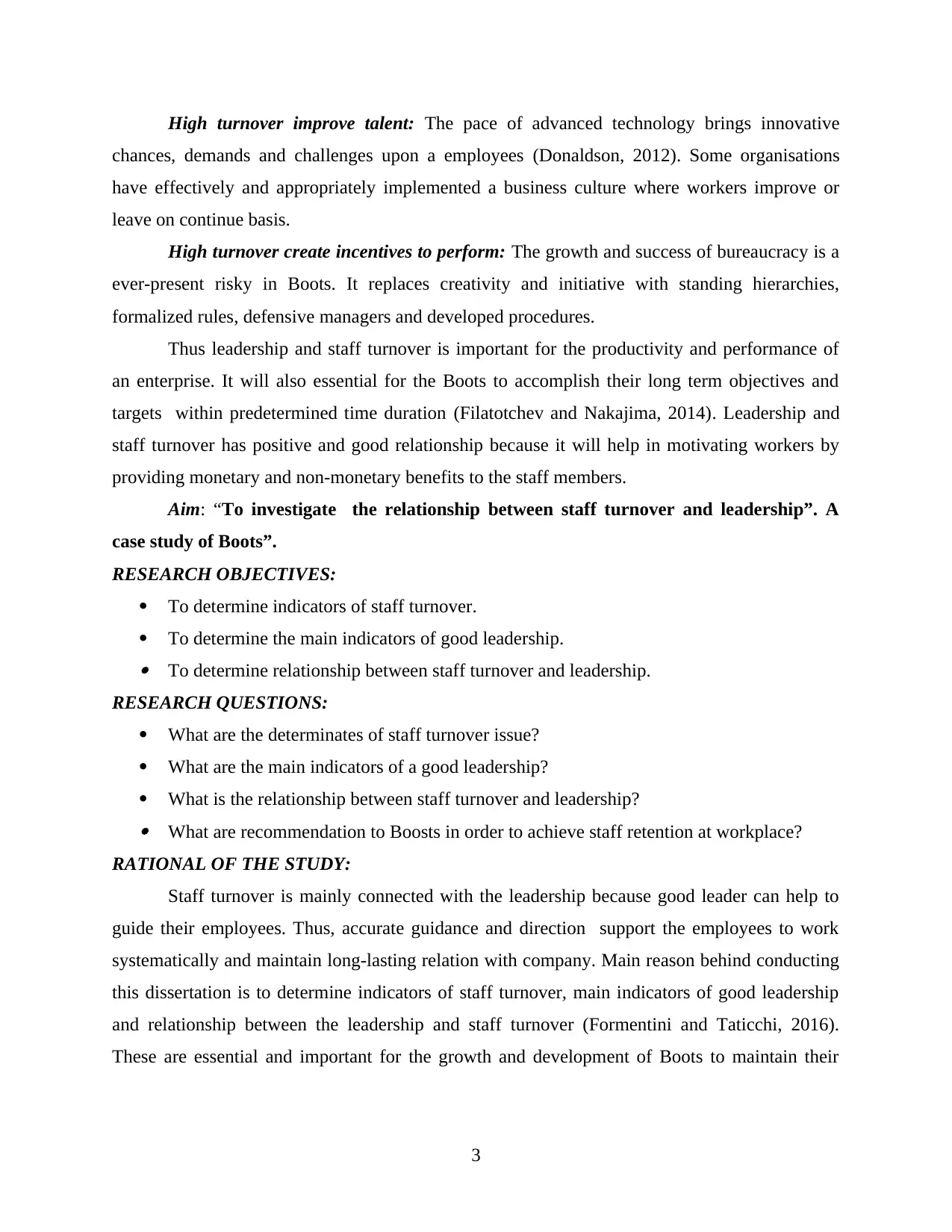
High turnover improve talent: The pace of advanced technology brings innovative
chances, demands and challenges upon a employees (Donaldson, 2012). Some organisations
have effectively and appropriately implemented a business culture where workers improve or
leave on continue basis.
High turnover create incentives to perform: The growth and success of bureaucracy is a
ever-present risky in Boots. It replaces creativity and initiative with standing hierarchies,
formalized rules, defensive managers and developed procedures.
Thus leadership and staff turnover is important for the productivity and performance of
an enterprise. It will also essential for the Boots to accomplish their long term objectives and
targets within predetermined time duration (Filatotchev and Nakajima, 2014). Leadership and
staff turnover has positive and good relationship because it will help in motivating workers by
providing monetary and non-monetary benefits to the staff members.
Aim: “To investigate the relationship between staff turnover and leadership”. A
case study of Boots”.
RESEARCH OBJECTIVES:
To determine indicators of staff turnover.
To determine the main indicators of good leadership. To determine relationship between staff turnover and leadership.
RESEARCH QUESTIONS:
What are the determinates of staff turnover issue?
What are the main indicators of a good leadership?
What is the relationship between staff turnover and leadership? What are recommendation to Boosts in order to achieve staff retention at workplace?
RATIONAL OF THE STUDY:
Staff turnover is mainly connected with the leadership because good leader can help to
guide their employees. Thus, accurate guidance and direction support the employees to work
systematically and maintain long-lasting relation with company. Main reason behind conducting
this dissertation is to determine indicators of staff turnover, main indicators of good leadership
and relationship between the leadership and staff turnover (Formentini and Taticchi, 2016).
These are essential and important for the growth and development of Boots to maintain their
3
chances, demands and challenges upon a employees (Donaldson, 2012). Some organisations
have effectively and appropriately implemented a business culture where workers improve or
leave on continue basis.
High turnover create incentives to perform: The growth and success of bureaucracy is a
ever-present risky in Boots. It replaces creativity and initiative with standing hierarchies,
formalized rules, defensive managers and developed procedures.
Thus leadership and staff turnover is important for the productivity and performance of
an enterprise. It will also essential for the Boots to accomplish their long term objectives and
targets within predetermined time duration (Filatotchev and Nakajima, 2014). Leadership and
staff turnover has positive and good relationship because it will help in motivating workers by
providing monetary and non-monetary benefits to the staff members.
Aim: “To investigate the relationship between staff turnover and leadership”. A
case study of Boots”.
RESEARCH OBJECTIVES:
To determine indicators of staff turnover.
To determine the main indicators of good leadership. To determine relationship between staff turnover and leadership.
RESEARCH QUESTIONS:
What are the determinates of staff turnover issue?
What are the main indicators of a good leadership?
What is the relationship between staff turnover and leadership? What are recommendation to Boosts in order to achieve staff retention at workplace?
RATIONAL OF THE STUDY:
Staff turnover is mainly connected with the leadership because good leader can help to
guide their employees. Thus, accurate guidance and direction support the employees to work
systematically and maintain long-lasting relation with company. Main reason behind conducting
this dissertation is to determine indicators of staff turnover, main indicators of good leadership
and relationship between the leadership and staff turnover (Formentini and Taticchi, 2016).
These are essential and important for the growth and development of Boots to maintain their
3
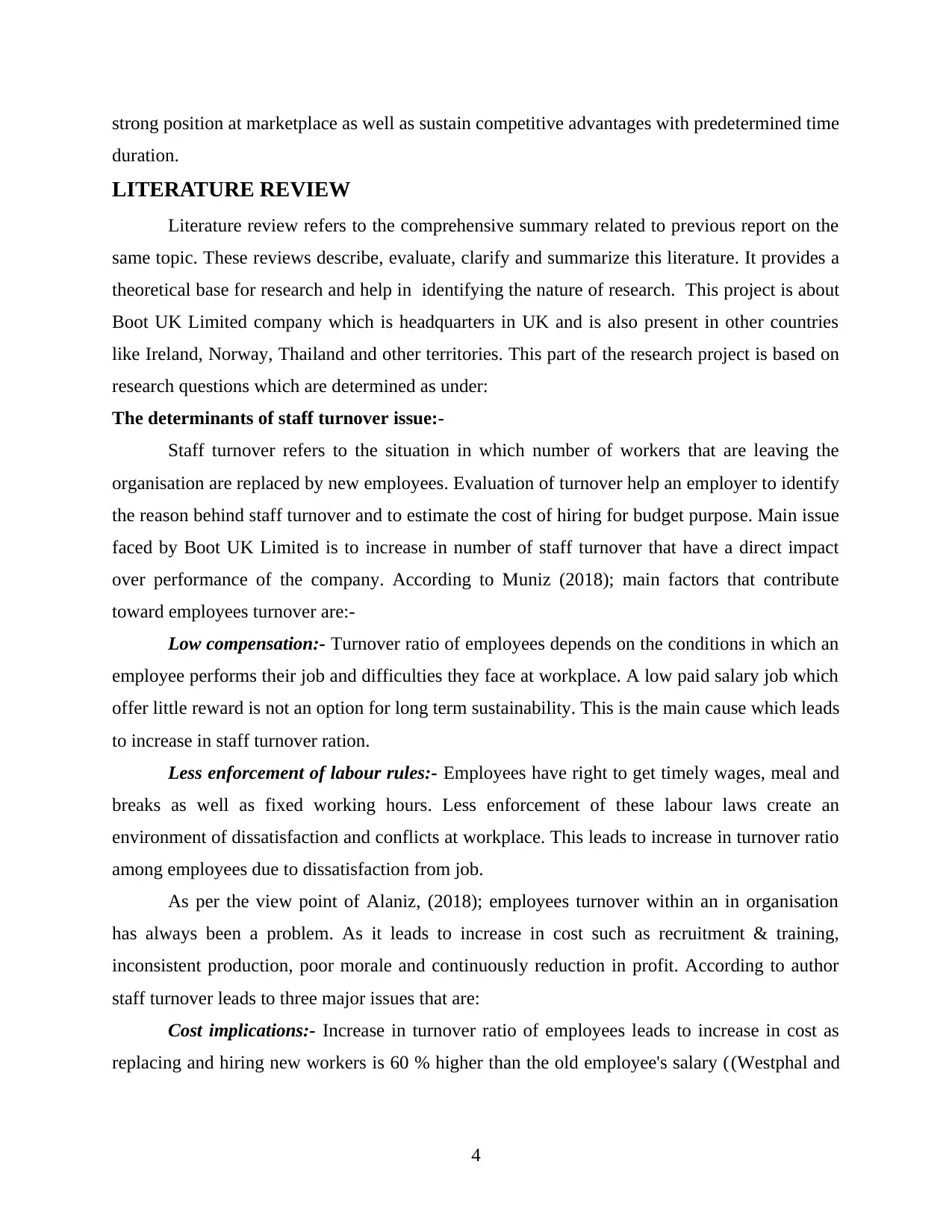
strong position at marketplace as well as sustain competitive advantages with predetermined time
duration.
LITERATURE REVIEW
Literature review refers to the comprehensive summary related to previous report on the
same topic. These reviews describe, evaluate, clarify and summarize this literature. It provides a
theoretical base for research and help in identifying the nature of research. This project is about
Boot UK Limited company which is headquarters in UK and is also present in other countries
like Ireland, Norway, Thailand and other territories. This part of the research project is based on
research questions which are determined as under:
The determinants of staff turnover issue:-
Staff turnover refers to the situation in which number of workers that are leaving the
organisation are replaced by new employees. Evaluation of turnover help an employer to identify
the reason behind staff turnover and to estimate the cost of hiring for budget purpose. Main issue
faced by Boot UK Limited is to increase in number of staff turnover that have a direct impact
over performance of the company. According to Muniz (2018); main factors that contribute
toward employees turnover are:-
Low compensation:- Turnover ratio of employees depends on the conditions in which an
employee performs their job and difficulties they face at workplace. A low paid salary job which
offer little reward is not an option for long term sustainability. This is the main cause which leads
to increase in staff turnover ration.
Less enforcement of labour rules:- Employees have right to get timely wages, meal and
breaks as well as fixed working hours. Less enforcement of these labour laws create an
environment of dissatisfaction and conflicts at workplace. This leads to increase in turnover ratio
among employees due to dissatisfaction from job.
As per the view point of Alaniz, (2018); employees turnover within an in organisation
has always been a problem. As it leads to increase in cost such as recruitment & training,
inconsistent production, poor morale and continuously reduction in profit. According to author
staff turnover leads to three major issues that are:
Cost implications:- Increase in turnover ratio of employees leads to increase in cost as
replacing and hiring new workers is 60 % higher than the old employee's salary ((Westphal and
4
duration.
LITERATURE REVIEW
Literature review refers to the comprehensive summary related to previous report on the
same topic. These reviews describe, evaluate, clarify and summarize this literature. It provides a
theoretical base for research and help in identifying the nature of research. This project is about
Boot UK Limited company which is headquarters in UK and is also present in other countries
like Ireland, Norway, Thailand and other territories. This part of the research project is based on
research questions which are determined as under:
The determinants of staff turnover issue:-
Staff turnover refers to the situation in which number of workers that are leaving the
organisation are replaced by new employees. Evaluation of turnover help an employer to identify
the reason behind staff turnover and to estimate the cost of hiring for budget purpose. Main issue
faced by Boot UK Limited is to increase in number of staff turnover that have a direct impact
over performance of the company. According to Muniz (2018); main factors that contribute
toward employees turnover are:-
Low compensation:- Turnover ratio of employees depends on the conditions in which an
employee performs their job and difficulties they face at workplace. A low paid salary job which
offer little reward is not an option for long term sustainability. This is the main cause which leads
to increase in staff turnover ration.
Less enforcement of labour rules:- Employees have right to get timely wages, meal and
breaks as well as fixed working hours. Less enforcement of these labour laws create an
environment of dissatisfaction and conflicts at workplace. This leads to increase in turnover ratio
among employees due to dissatisfaction from job.
As per the view point of Alaniz, (2018); employees turnover within an in organisation
has always been a problem. As it leads to increase in cost such as recruitment & training,
inconsistent production, poor morale and continuously reduction in profit. According to author
staff turnover leads to three major issues that are:
Cost implications:- Increase in turnover ratio of employees leads to increase in cost as
replacing and hiring new workers is 60 % higher than the old employee's salary ((Westphal and
4
⊘ This is a preview!⊘
Do you want full access?
Subscribe today to unlock all pages.

Trusted by 1+ million students worldwide
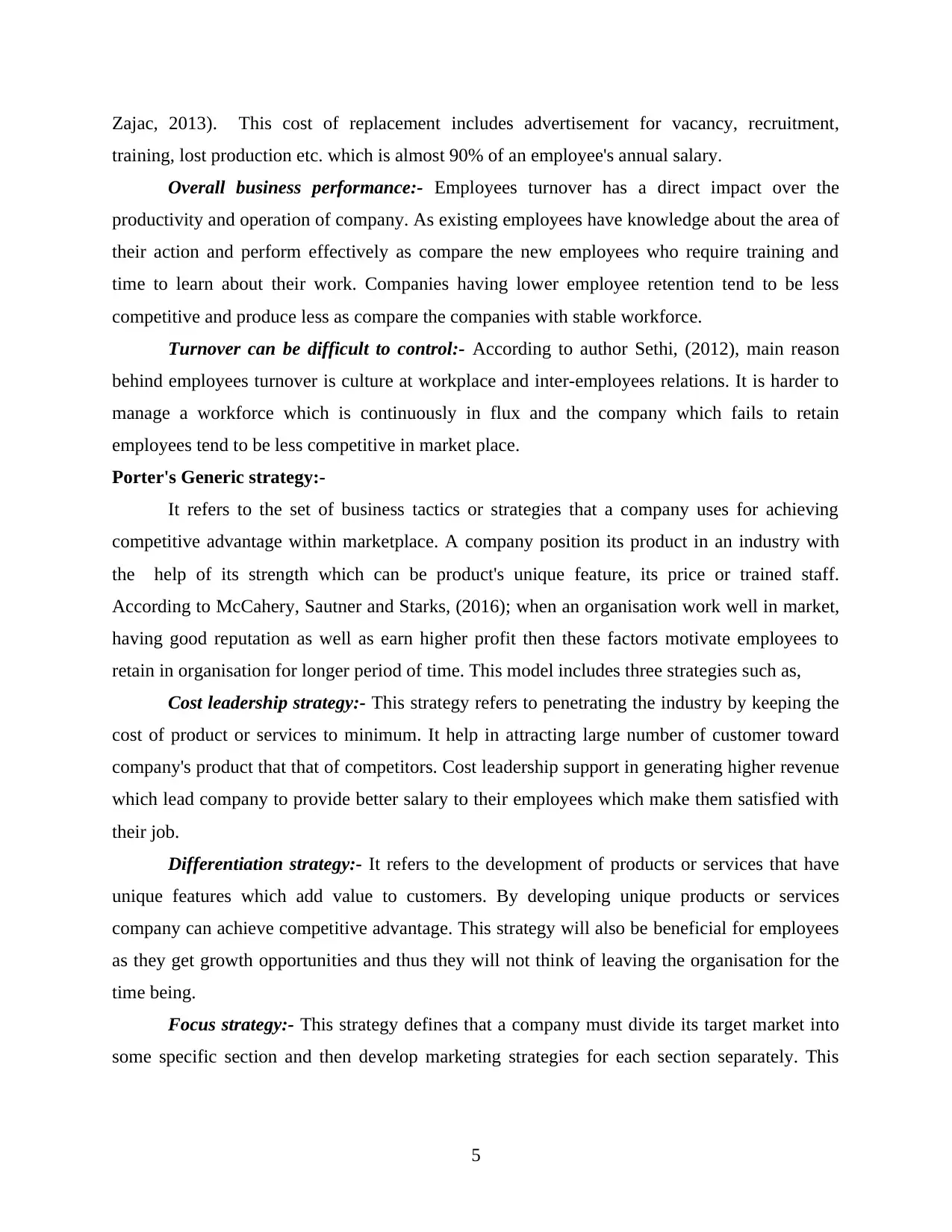
Zajac, 2013). This cost of replacement includes advertisement for vacancy, recruitment,
training, lost production etc. which is almost 90% of an employee's annual salary.
Overall business performance:- Employees turnover has a direct impact over the
productivity and operation of company. As existing employees have knowledge about the area of
their action and perform effectively as compare the new employees who require training and
time to learn about their work. Companies having lower employee retention tend to be less
competitive and produce less as compare the companies with stable workforce.
Turnover can be difficult to control:- According to author Sethi, (2012), main reason
behind employees turnover is culture at workplace and inter-employees relations. It is harder to
manage a workforce which is continuously in flux and the company which fails to retain
employees tend to be less competitive in market place.
Porter's Generic strategy:-
It refers to the set of business tactics or strategies that a company uses for achieving
competitive advantage within marketplace. A company position its product in an industry with
the help of its strength which can be product's unique feature, its price or trained staff.
According to McCahery, Sautner and Starks, (2016); when an organisation work well in market,
having good reputation as well as earn higher profit then these factors motivate employees to
retain in organisation for longer period of time. This model includes three strategies such as,
Cost leadership strategy:- This strategy refers to penetrating the industry by keeping the
cost of product or services to minimum. It help in attracting large number of customer toward
company's product that that of competitors. Cost leadership support in generating higher revenue
which lead company to provide better salary to their employees which make them satisfied with
their job.
Differentiation strategy:- It refers to the development of products or services that have
unique features which add value to customers. By developing unique products or services
company can achieve competitive advantage. This strategy will also be beneficial for employees
as they get growth opportunities and thus they will not think of leaving the organisation for the
time being.
Focus strategy:- This strategy defines that a company must divide its target market into
some specific section and then develop marketing strategies for each section separately. This
5
training, lost production etc. which is almost 90% of an employee's annual salary.
Overall business performance:- Employees turnover has a direct impact over the
productivity and operation of company. As existing employees have knowledge about the area of
their action and perform effectively as compare the new employees who require training and
time to learn about their work. Companies having lower employee retention tend to be less
competitive and produce less as compare the companies with stable workforce.
Turnover can be difficult to control:- According to author Sethi, (2012), main reason
behind employees turnover is culture at workplace and inter-employees relations. It is harder to
manage a workforce which is continuously in flux and the company which fails to retain
employees tend to be less competitive in market place.
Porter's Generic strategy:-
It refers to the set of business tactics or strategies that a company uses for achieving
competitive advantage within marketplace. A company position its product in an industry with
the help of its strength which can be product's unique feature, its price or trained staff.
According to McCahery, Sautner and Starks, (2016); when an organisation work well in market,
having good reputation as well as earn higher profit then these factors motivate employees to
retain in organisation for longer period of time. This model includes three strategies such as,
Cost leadership strategy:- This strategy refers to penetrating the industry by keeping the
cost of product or services to minimum. It help in attracting large number of customer toward
company's product that that of competitors. Cost leadership support in generating higher revenue
which lead company to provide better salary to their employees which make them satisfied with
their job.
Differentiation strategy:- It refers to the development of products or services that have
unique features which add value to customers. By developing unique products or services
company can achieve competitive advantage. This strategy will also be beneficial for employees
as they get growth opportunities and thus they will not think of leaving the organisation for the
time being.
Focus strategy:- This strategy defines that a company must divide its target market into
some specific section and then develop marketing strategies for each section separately. This
5
Paraphrase This Document
Need a fresh take? Get an instant paraphrase of this document with our AI Paraphraser
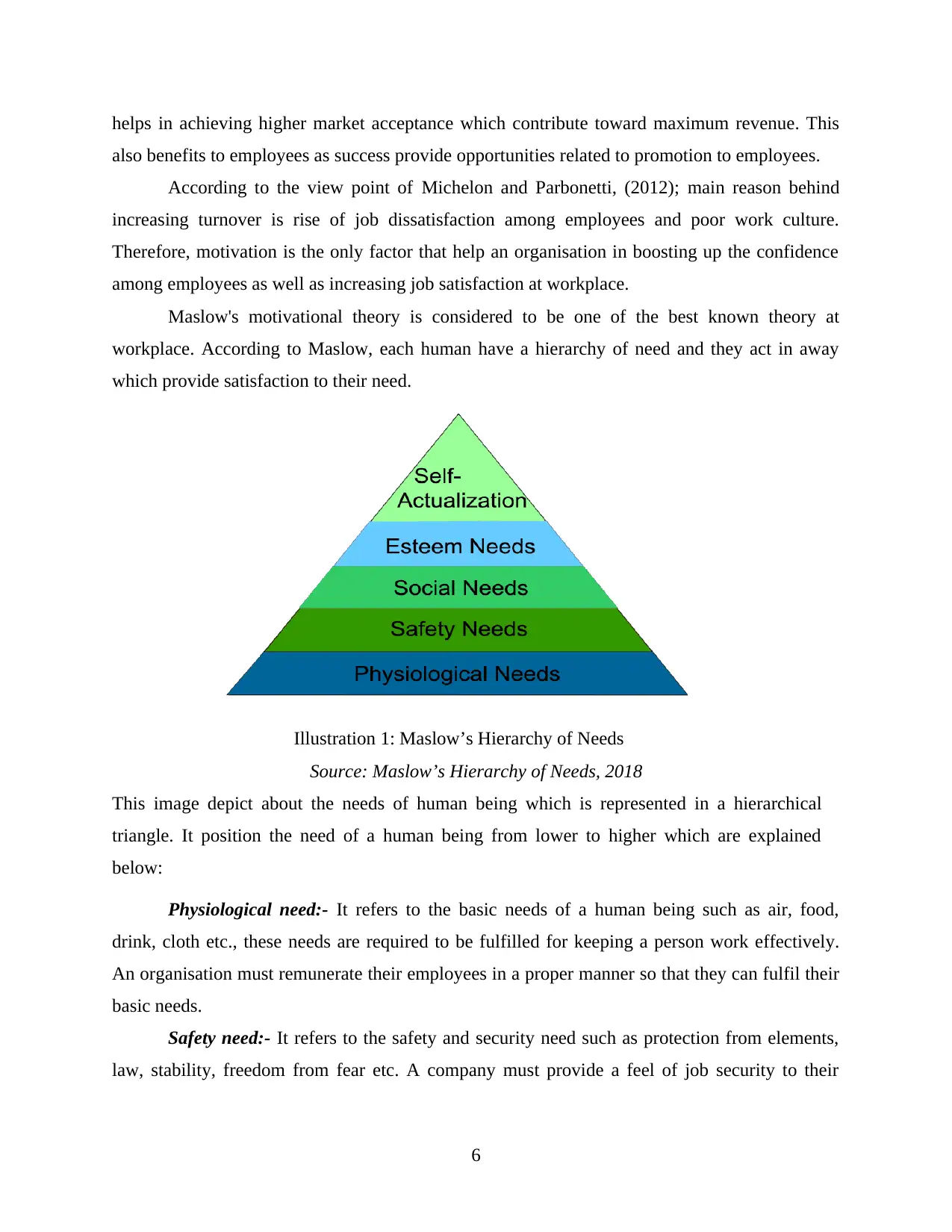
helps in achieving higher market acceptance which contribute toward maximum revenue. This
also benefits to employees as success provide opportunities related to promotion to employees.
According to the view point of Michelon and Parbonetti, (2012); main reason behind
increasing turnover is rise of job dissatisfaction among employees and poor work culture.
Therefore, motivation is the only factor that help an organisation in boosting up the confidence
among employees as well as increasing job satisfaction at workplace.
Maslow's motivational theory is considered to be one of the best known theory at
workplace. According to Maslow, each human have a hierarchy of need and they act in away
which provide satisfaction to their need.
Source: Maslow’s Hierarchy of Needs, 2018
This image depict about the needs of human being which is represented in a hierarchical
triangle. It position the need of a human being from lower to higher which are explained
below:
Physiological need:- It refers to the basic needs of a human being such as air, food,
drink, cloth etc., these needs are required to be fulfilled for keeping a person work effectively.
An organisation must remunerate their employees in a proper manner so that they can fulfil their
basic needs.
Safety need:- It refers to the safety and security need such as protection from elements,
law, stability, freedom from fear etc. A company must provide a feel of job security to their
6
Illustration 1: Maslow’s Hierarchy of Needs
also benefits to employees as success provide opportunities related to promotion to employees.
According to the view point of Michelon and Parbonetti, (2012); main reason behind
increasing turnover is rise of job dissatisfaction among employees and poor work culture.
Therefore, motivation is the only factor that help an organisation in boosting up the confidence
among employees as well as increasing job satisfaction at workplace.
Maslow's motivational theory is considered to be one of the best known theory at
workplace. According to Maslow, each human have a hierarchy of need and they act in away
which provide satisfaction to their need.
Source: Maslow’s Hierarchy of Needs, 2018
This image depict about the needs of human being which is represented in a hierarchical
triangle. It position the need of a human being from lower to higher which are explained
below:
Physiological need:- It refers to the basic needs of a human being such as air, food,
drink, cloth etc., these needs are required to be fulfilled for keeping a person work effectively.
An organisation must remunerate their employees in a proper manner so that they can fulfil their
basic needs.
Safety need:- It refers to the safety and security need such as protection from elements,
law, stability, freedom from fear etc. A company must provide a feel of job security to their
6
Illustration 1: Maslow’s Hierarchy of Needs
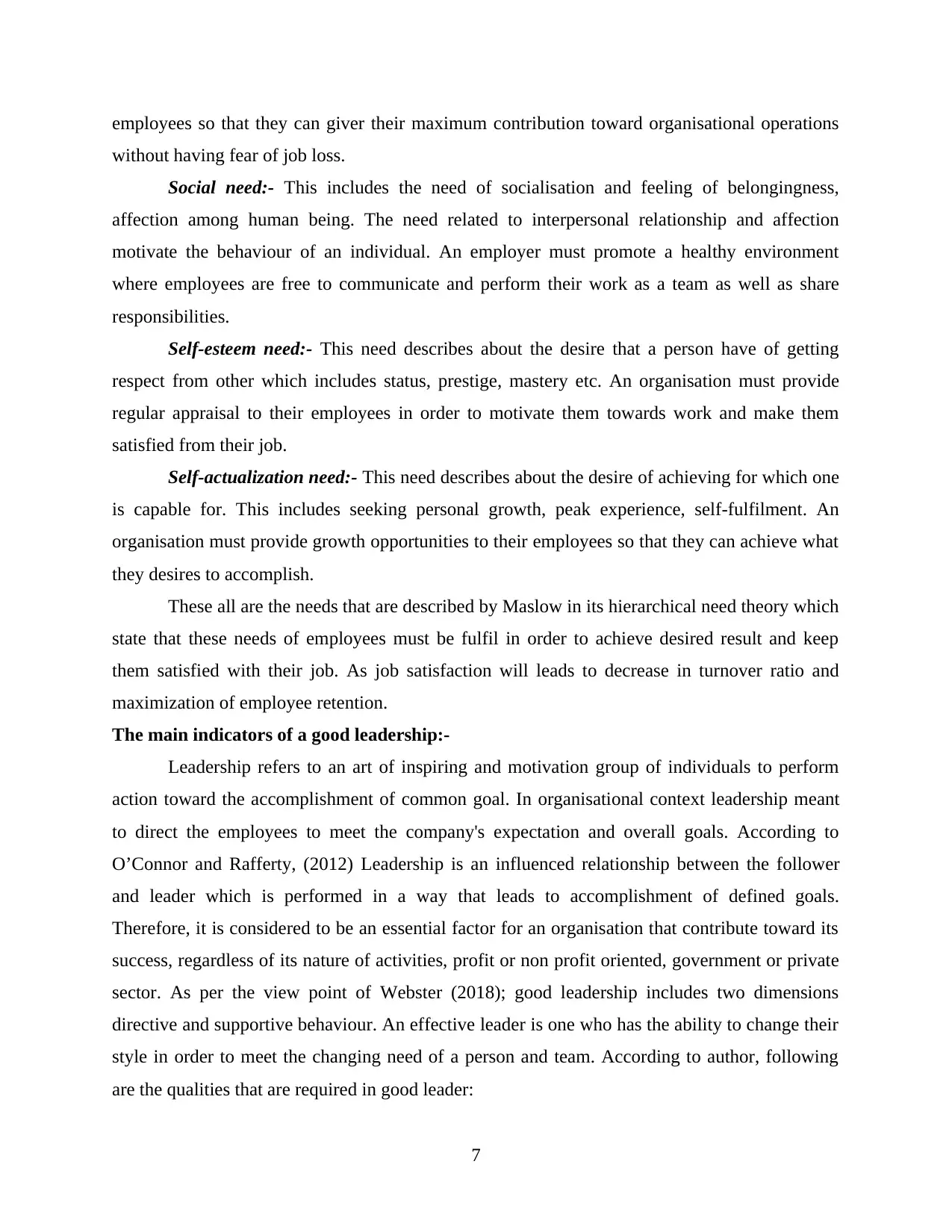
employees so that they can giver their maximum contribution toward organisational operations
without having fear of job loss.
Social need:- This includes the need of socialisation and feeling of belongingness,
affection among human being. The need related to interpersonal relationship and affection
motivate the behaviour of an individual. An employer must promote a healthy environment
where employees are free to communicate and perform their work as a team as well as share
responsibilities.
Self-esteem need:- This need describes about the desire that a person have of getting
respect from other which includes status, prestige, mastery etc. An organisation must provide
regular appraisal to their employees in order to motivate them towards work and make them
satisfied from their job.
Self-actualization need:- This need describes about the desire of achieving for which one
is capable for. This includes seeking personal growth, peak experience, self-fulfilment. An
organisation must provide growth opportunities to their employees so that they can achieve what
they desires to accomplish.
These all are the needs that are described by Maslow in its hierarchical need theory which
state that these needs of employees must be fulfil in order to achieve desired result and keep
them satisfied with their job. As job satisfaction will leads to decrease in turnover ratio and
maximization of employee retention.
The main indicators of a good leadership:-
Leadership refers to an art of inspiring and motivation group of individuals to perform
action toward the accomplishment of common goal. In organisational context leadership meant
to direct the employees to meet the company's expectation and overall goals. According to
O’Connor and Rafferty, (2012) Leadership is an influenced relationship between the follower
and leader which is performed in a way that leads to accomplishment of defined goals.
Therefore, it is considered to be an essential factor for an organisation that contribute toward its
success, regardless of its nature of activities, profit or non profit oriented, government or private
sector. As per the view point of Webster (2018); good leadership includes two dimensions
directive and supportive behaviour. An effective leader is one who has the ability to change their
style in order to meet the changing need of a person and team. According to author, following
are the qualities that are required in good leader:
7
without having fear of job loss.
Social need:- This includes the need of socialisation and feeling of belongingness,
affection among human being. The need related to interpersonal relationship and affection
motivate the behaviour of an individual. An employer must promote a healthy environment
where employees are free to communicate and perform their work as a team as well as share
responsibilities.
Self-esteem need:- This need describes about the desire that a person have of getting
respect from other which includes status, prestige, mastery etc. An organisation must provide
regular appraisal to their employees in order to motivate them towards work and make them
satisfied from their job.
Self-actualization need:- This need describes about the desire of achieving for which one
is capable for. This includes seeking personal growth, peak experience, self-fulfilment. An
organisation must provide growth opportunities to their employees so that they can achieve what
they desires to accomplish.
These all are the needs that are described by Maslow in its hierarchical need theory which
state that these needs of employees must be fulfil in order to achieve desired result and keep
them satisfied with their job. As job satisfaction will leads to decrease in turnover ratio and
maximization of employee retention.
The main indicators of a good leadership:-
Leadership refers to an art of inspiring and motivation group of individuals to perform
action toward the accomplishment of common goal. In organisational context leadership meant
to direct the employees to meet the company's expectation and overall goals. According to
O’Connor and Rafferty, (2012) Leadership is an influenced relationship between the follower
and leader which is performed in a way that leads to accomplishment of defined goals.
Therefore, it is considered to be an essential factor for an organisation that contribute toward its
success, regardless of its nature of activities, profit or non profit oriented, government or private
sector. As per the view point of Webster (2018); good leadership includes two dimensions
directive and supportive behaviour. An effective leader is one who has the ability to change their
style in order to meet the changing need of a person and team. According to author, following
are the qualities that are required in good leader:
7
⊘ This is a preview!⊘
Do you want full access?
Subscribe today to unlock all pages.

Trusted by 1+ million students worldwide
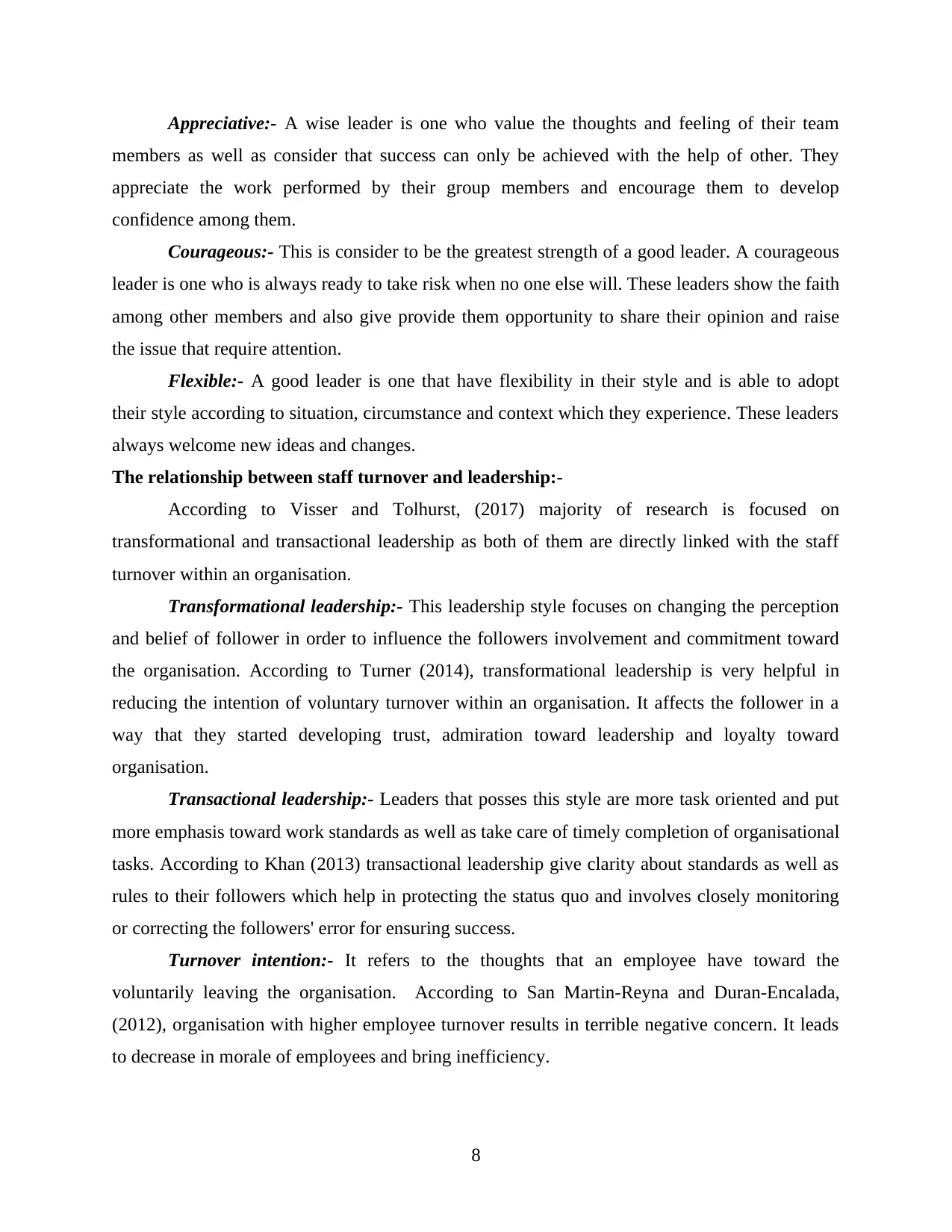
Appreciative:- A wise leader is one who value the thoughts and feeling of their team
members as well as consider that success can only be achieved with the help of other. They
appreciate the work performed by their group members and encourage them to develop
confidence among them.
Courageous:- This is consider to be the greatest strength of a good leader. A courageous
leader is one who is always ready to take risk when no one else will. These leaders show the faith
among other members and also give provide them opportunity to share their opinion and raise
the issue that require attention.
Flexible:- A good leader is one that have flexibility in their style and is able to adopt
their style according to situation, circumstance and context which they experience. These leaders
always welcome new ideas and changes.
The relationship between staff turnover and leadership:-
According to Visser and Tolhurst, (2017) majority of research is focused on
transformational and transactional leadership as both of them are directly linked with the staff
turnover within an organisation.
Transformational leadership:- This leadership style focuses on changing the perception
and belief of follower in order to influence the followers involvement and commitment toward
the organisation. According to Turner (2014), transformational leadership is very helpful in
reducing the intention of voluntary turnover within an organisation. It affects the follower in a
way that they started developing trust, admiration toward leadership and loyalty toward
organisation.
Transactional leadership:- Leaders that posses this style are more task oriented and put
more emphasis toward work standards as well as take care of timely completion of organisational
tasks. According to Khan (2013) transactional leadership give clarity about standards as well as
rules to their followers which help in protecting the status quo and involves closely monitoring
or correcting the followers' error for ensuring success.
Turnover intention:- It refers to the thoughts that an employee have toward the
voluntarily leaving the organisation. According to San Martin-Reyna and Duran-Encalada,
(2012), organisation with higher employee turnover results in terrible negative concern. It leads
to decrease in morale of employees and bring inefficiency.
8
members as well as consider that success can only be achieved with the help of other. They
appreciate the work performed by their group members and encourage them to develop
confidence among them.
Courageous:- This is consider to be the greatest strength of a good leader. A courageous
leader is one who is always ready to take risk when no one else will. These leaders show the faith
among other members and also give provide them opportunity to share their opinion and raise
the issue that require attention.
Flexible:- A good leader is one that have flexibility in their style and is able to adopt
their style according to situation, circumstance and context which they experience. These leaders
always welcome new ideas and changes.
The relationship between staff turnover and leadership:-
According to Visser and Tolhurst, (2017) majority of research is focused on
transformational and transactional leadership as both of them are directly linked with the staff
turnover within an organisation.
Transformational leadership:- This leadership style focuses on changing the perception
and belief of follower in order to influence the followers involvement and commitment toward
the organisation. According to Turner (2014), transformational leadership is very helpful in
reducing the intention of voluntary turnover within an organisation. It affects the follower in a
way that they started developing trust, admiration toward leadership and loyalty toward
organisation.
Transactional leadership:- Leaders that posses this style are more task oriented and put
more emphasis toward work standards as well as take care of timely completion of organisational
tasks. According to Khan (2013) transactional leadership give clarity about standards as well as
rules to their followers which help in protecting the status quo and involves closely monitoring
or correcting the followers' error for ensuring success.
Turnover intention:- It refers to the thoughts that an employee have toward the
voluntarily leaving the organisation. According to San Martin-Reyna and Duran-Encalada,
(2012), organisation with higher employee turnover results in terrible negative concern. It leads
to decrease in morale of employees and bring inefficiency.
8
Paraphrase This Document
Need a fresh take? Get an instant paraphrase of this document with our AI Paraphraser
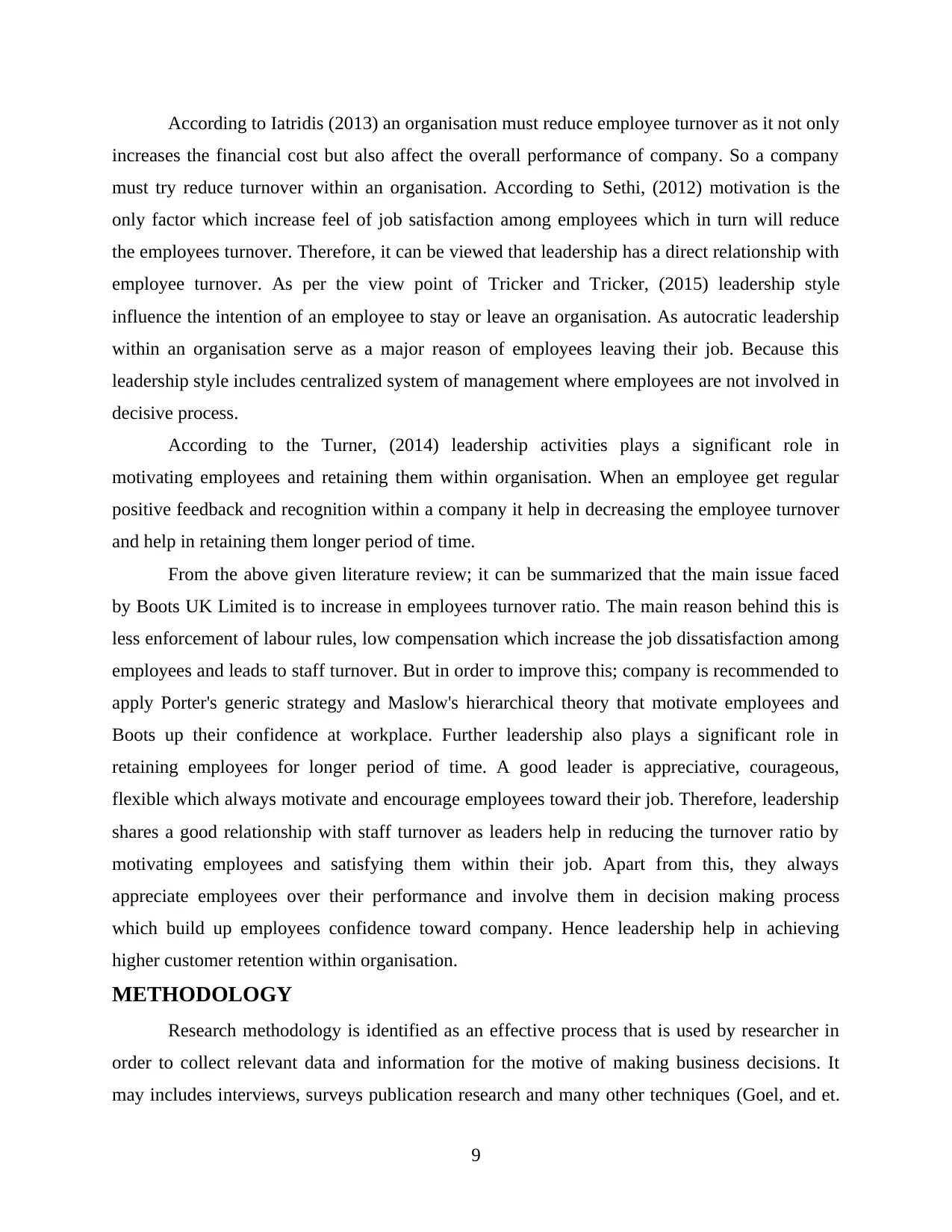
According to Iatridis (2013) an organisation must reduce employee turnover as it not only
increases the financial cost but also affect the overall performance of company. So a company
must try reduce turnover within an organisation. According to Sethi, (2012) motivation is the
only factor which increase feel of job satisfaction among employees which in turn will reduce
the employees turnover. Therefore, it can be viewed that leadership has a direct relationship with
employee turnover. As per the view point of Tricker and Tricker, (2015) leadership style
influence the intention of an employee to stay or leave an organisation. As autocratic leadership
within an organisation serve as a major reason of employees leaving their job. Because this
leadership style includes centralized system of management where employees are not involved in
decisive process.
According to the Turner, (2014) leadership activities plays a significant role in
motivating employees and retaining them within organisation. When an employee get regular
positive feedback and recognition within a company it help in decreasing the employee turnover
and help in retaining them longer period of time.
From the above given literature review; it can be summarized that the main issue faced
by Boots UK Limited is to increase in employees turnover ratio. The main reason behind this is
less enforcement of labour rules, low compensation which increase the job dissatisfaction among
employees and leads to staff turnover. But in order to improve this; company is recommended to
apply Porter's generic strategy and Maslow's hierarchical theory that motivate employees and
Boots up their confidence at workplace. Further leadership also plays a significant role in
retaining employees for longer period of time. A good leader is appreciative, courageous,
flexible which always motivate and encourage employees toward their job. Therefore, leadership
shares a good relationship with staff turnover as leaders help in reducing the turnover ratio by
motivating employees and satisfying them within their job. Apart from this, they always
appreciate employees over their performance and involve them in decision making process
which build up employees confidence toward company. Hence leadership help in achieving
higher customer retention within organisation.
METHODOLOGY
Research methodology is identified as an effective process that is used by researcher in
order to collect relevant data and information for the motive of making business decisions. It
may includes interviews, surveys publication research and many other techniques (Goel, and et.
9
increases the financial cost but also affect the overall performance of company. So a company
must try reduce turnover within an organisation. According to Sethi, (2012) motivation is the
only factor which increase feel of job satisfaction among employees which in turn will reduce
the employees turnover. Therefore, it can be viewed that leadership has a direct relationship with
employee turnover. As per the view point of Tricker and Tricker, (2015) leadership style
influence the intention of an employee to stay or leave an organisation. As autocratic leadership
within an organisation serve as a major reason of employees leaving their job. Because this
leadership style includes centralized system of management where employees are not involved in
decisive process.
According to the Turner, (2014) leadership activities plays a significant role in
motivating employees and retaining them within organisation. When an employee get regular
positive feedback and recognition within a company it help in decreasing the employee turnover
and help in retaining them longer period of time.
From the above given literature review; it can be summarized that the main issue faced
by Boots UK Limited is to increase in employees turnover ratio. The main reason behind this is
less enforcement of labour rules, low compensation which increase the job dissatisfaction among
employees and leads to staff turnover. But in order to improve this; company is recommended to
apply Porter's generic strategy and Maslow's hierarchical theory that motivate employees and
Boots up their confidence at workplace. Further leadership also plays a significant role in
retaining employees for longer period of time. A good leader is appreciative, courageous,
flexible which always motivate and encourage employees toward their job. Therefore, leadership
shares a good relationship with staff turnover as leaders help in reducing the turnover ratio by
motivating employees and satisfying them within their job. Apart from this, they always
appreciate employees over their performance and involve them in decision making process
which build up employees confidence toward company. Hence leadership help in achieving
higher customer retention within organisation.
METHODOLOGY
Research methodology is identified as an effective process that is used by researcher in
order to collect relevant data and information for the motive of making business decisions. It
may includes interviews, surveys publication research and many other techniques (Goel, and et.
9
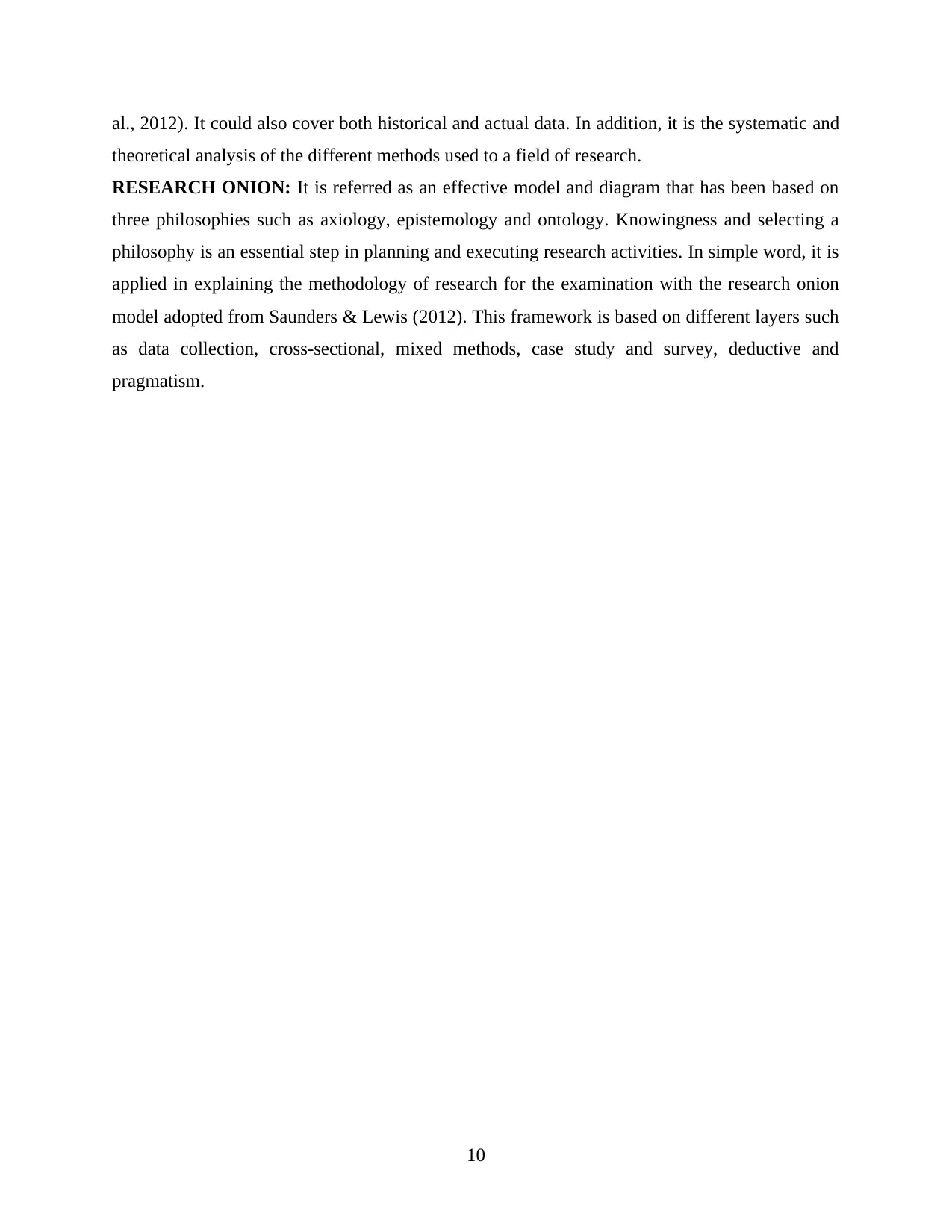
al., 2012). It could also cover both historical and actual data. In addition, it is the systematic and
theoretical analysis of the different methods used to a field of research.
RESEARCH ONION: It is referred as an effective model and diagram that has been based on
three philosophies such as axiology, epistemology and ontology. Knowingness and selecting a
philosophy is an essential step in planning and executing research activities. In simple word, it is
applied in explaining the methodology of research for the examination with the research onion
model adopted from Saunders & Lewis (2012). This framework is based on different layers such
as data collection, cross-sectional, mixed methods, case study and survey, deductive and
pragmatism.
10
theoretical analysis of the different methods used to a field of research.
RESEARCH ONION: It is referred as an effective model and diagram that has been based on
three philosophies such as axiology, epistemology and ontology. Knowingness and selecting a
philosophy is an essential step in planning and executing research activities. In simple word, it is
applied in explaining the methodology of research for the examination with the research onion
model adopted from Saunders & Lewis (2012). This framework is based on different layers such
as data collection, cross-sectional, mixed methods, case study and survey, deductive and
pragmatism.
10
⊘ This is a preview!⊘
Do you want full access?
Subscribe today to unlock all pages.

Trusted by 1+ million students worldwide
1 out of 32
Related Documents
Your All-in-One AI-Powered Toolkit for Academic Success.
+13062052269
info@desklib.com
Available 24*7 on WhatsApp / Email
![[object Object]](/_next/static/media/star-bottom.7253800d.svg)
Unlock your academic potential
Copyright © 2020–2025 A2Z Services. All Rights Reserved. Developed and managed by ZUCOL.





